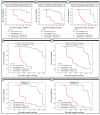Glutathione Reductase Expression and Its Prognostic Significance in Colon Cancer
- PMID: 38256170
- PMCID: PMC10816751
- DOI: 10.3390/ijms25021097
Glutathione Reductase Expression and Its Prognostic Significance in Colon Cancer
Abstract
Maintaining a balanced redox state within cells is crucial for the sustenance of life. The process involves continuous cytosolic disulfide reduction reactions to restore oxidized proteins to their reduced thiol forms. There are two main cellular antioxidant pathways-the thioredoxin (Trx) and glutathione (GSH)/glutaredoxin (Grx) systems. In the GSH/Grx system, glutathione reductase (GR; GSR) catalyses the reduction of GSH disulfide (GSSG) to its sulfhydryl form (GSH), which can then further reduce oxidized Grxs. GR is an essential enzyme that helps in maintaining the supply of reduced glutathione-GSH, which is a significant reducing thiol found in most cells and known for its antioxidant properties. Therefore, it can have a significant impact on cancer development. To investigate this further, we performed an immunohistochemical analysis of GR protein expression in colon adenocarcinoma samples collected from patients with primary colon adenocarcinoma (stage I and II) and patients with metastasis to regional lymph nodes (stage III). The results of our study revealed a significant relationship between the immunohistochemical expression of GR and tumour histological grade, depth of invasion, regional lymph node involvement, staging, and PCNA immunohistochemical expression. It was found that 95% of patients with stage I had low levels of GR expression, whereas 89% of patients with stage III had high levels of immunohistochemical expression. A high level of expression was also detected in the patients with stage II of the disease, where almost 63% were characterized by a high expression of GR. The Western blot method revealed that the highest level of expression was found in the LS 174T cell line, which corresponds to stage II. The results of our study indicate that the immunohistochemical expression of GR may act as an independent prognostic factor associated with colon adenocarcinoma patients' prognosis.
Keywords: ELISA; Western blot; chromosomal instability (CIN); colorectal cancer; glutaredoxin; glutathione system (GSH); oxidative stress; prognostic factor; redox homeostasis.
Conflict of interest statement
The authors declare no conflicts of interest.
Figures










Similar articles
-
Glutaredoxin 2 Protein (Grx2) as an Independent Prognostic Factor Associated with the Survival of Colon Adenocarcinoma Patients.Int J Mol Sci. 2024 Jan 15;25(2):1060. doi: 10.3390/ijms25021060. Int J Mol Sci. 2024. PMID: 38256132 Free PMC article.
-
The thioredoxin antioxidant system.Free Radic Biol Med. 2014 Jan;66:75-87. doi: 10.1016/j.freeradbiomed.2013.07.036. Epub 2013 Jul 27. Free Radic Biol Med. 2014. PMID: 23899494 Review.
-
A Prognostic Activity of Glutaredoxin 1 Protein (Grx1) in Colon Cancer.Int J Mol Sci. 2024 Jan 13;25(2):1007. doi: 10.3390/ijms25021007. Int J Mol Sci. 2024. PMID: 38256082 Free PMC article.
-
Thiol-metabolizing proteins and endothelial redox state: differential modulation of eNOS and biopterin pathways.Am J Physiol Heart Circ Physiol. 2010 Jan;298(1):H194-201. doi: 10.1152/ajpheart.00767.2009. Epub 2009 Nov 6. Am J Physiol Heart Circ Physiol. 2010. PMID: 19897710 Free PMC article.
-
Glutathione and Glutaredoxin-Key Players in Cellular Redox Homeostasis and Signaling.Antioxidants (Basel). 2023 Aug 3;12(8):1553. doi: 10.3390/antiox12081553. Antioxidants (Basel). 2023. PMID: 37627548 Free PMC article. Review.
Cited by
-
SLC14A1 and TGF-β signaling: a feedback loop driving EMT and colorectal cancer metachronous liver metastasis.J Exp Clin Cancer Res. 2024 Jul 27;43(1):208. doi: 10.1186/s13046-024-03114-8. J Exp Clin Cancer Res. 2024. PMID: 39061061 Free PMC article.
-
Uncovering Metabolic Alterations in HCT-116 Colon Cancer Cells upon Exposure to Bamboo Leaf Extract Obtained from Guadua incana Londoño.Molecules. 2024 Jun 23;29(13):2985. doi: 10.3390/molecules29132985. Molecules. 2024. PMID: 38998936 Free PMC article.
-
Serum glutathione reductase level as a disease activity biomarker in systemic lupus erythematosus: a single-centre preliminary study.Lupus Sci Med. 2025 Jun 24;12(1):e001593. doi: 10.1136/lupus-2025-001593. Lupus Sci Med. 2025. PMID: 40555556 Free PMC article.
-
Network pharmacology and bioinformatics insight into the mechanism of GeGen-QinLian decoction in colorectal cancer and type 2 diabetes mellitus.Medicine (Baltimore). 2025 Jul 18;104(29):e43274. doi: 10.1097/MD.0000000000043274. Medicine (Baltimore). 2025. PMID: 40696679 Free PMC article.
References
MeSH terms
Substances
LinkOut - more resources
Full Text Sources
Miscellaneous

